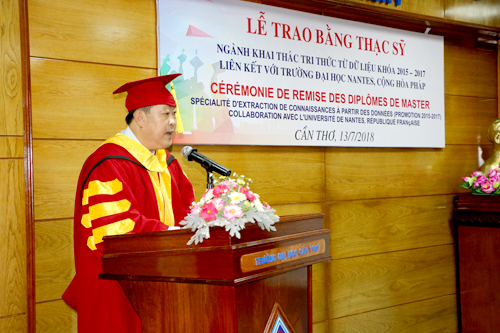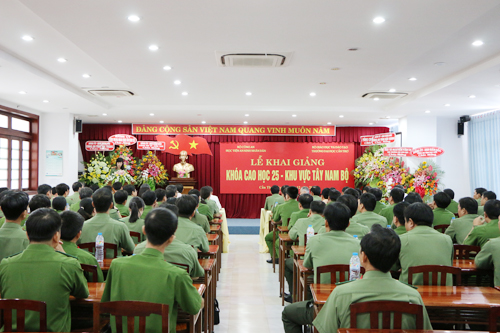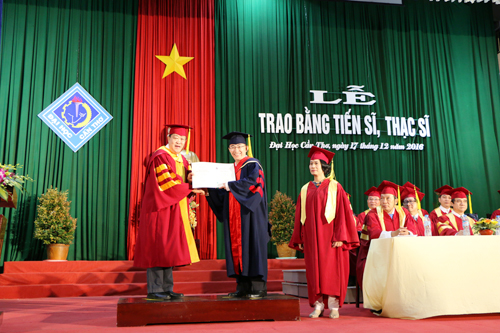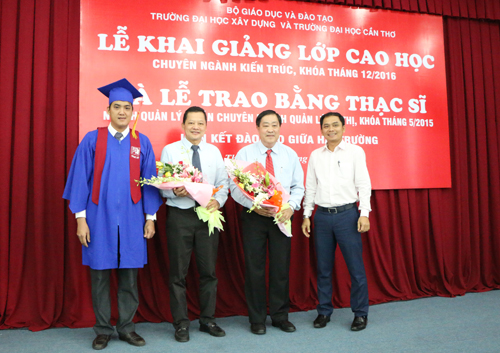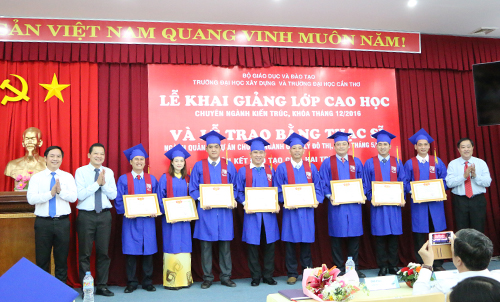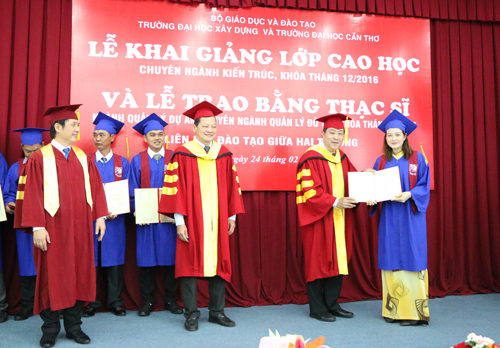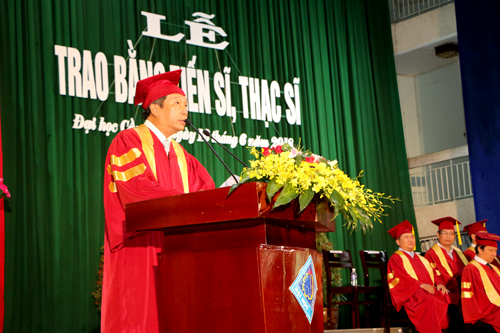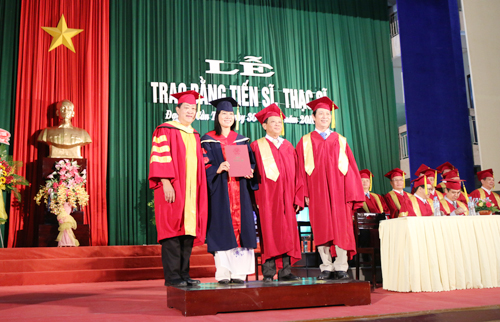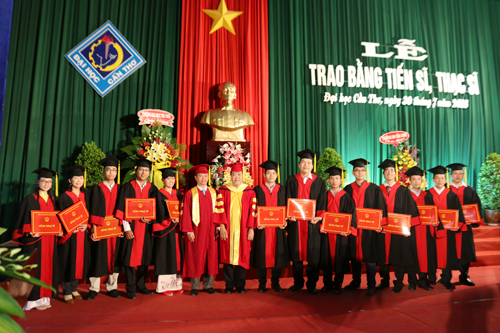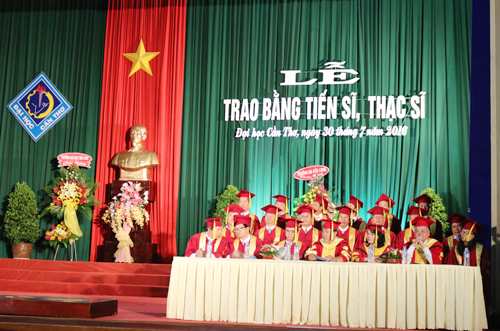
Tên đề tài: “Nghiên cứu ứng dụng enzyme protease trong chế biến bột protein thủy phân từ phụ phẩm cá tra sử dụng làm môi trường nuôi cấy vi sinh vật”.
Tác giả: Đặng Minh Hiền, Khóa: 2014
Chuyên ngành: Công nghệ thực phẩm; Mã số: 62540101. Nhóm ngành: Công nghệ sản xuất và chế biến
Người hướng dẫn: PGS.TS. Nguyễn Công Hà, Trường Đại học Cần Thơ.
- Tóm tắt nội dung luận án
Sản xuất bột protein thủy phân từ phụ phẩm cá tra bằng enzyme ngoại bào nhằm tăng thêm giá trị cho phụ phẩm cá tra giàu protein, góp phần tạo nên một giải pháp thay thế mới đầy hứa hẹn và thân thiện với môi trường. Tận dụng hiệu quả và sử dụng thành công nguồn phụ phẩm này làm protein thủy phân giúp tăng lợi nhuận và góp phần phát triển bền vững ngành nuôi trồng, chế biến thủy sản. Nghiên cứu này cung cấp thông tin kỹ thuật mới quan trọng để lựa chọn protease và các điều kiện chế biến để tối ưu hóa hiệu quả, từ phụ phẩm cá tra sử dụng phương pháp thủy phân bằng enzyme với mục tiêu sử dụng các phụ phẩm này như nguồn peptone cho vi sinh vật sinh tổng hợp.
Nghiên cứu đã ghi nhận các kết quả như sau: (1) Nội dung 1: kết quả cho thấy phụ phẩm thịt dè cá tra được tách béo bởi dung dịch NaHCO3 ở nồng độ 0,2%, có khả năng tách béo tốt nhất, hiệu suất thủy phân của các enzyme hiệu quả ở tỷ lệ khối lượng enzyme và cơ chất là 2,25 mg enzyme (mgE)/1,17 g protein (gPro) đối với enzyme bromelain, 1,5 mgE/1,17gPro đối với enzyme papain và 0,625 mgE/0,975 gPro đối với enzyme neutrase; bên cạnh đó, hiệu suất thủy phân tyrosin và đạm amin bằng enzyme bromelain ở thời điểm 240 phút tương ứng 65,25% và 71,02%, của enzyme papain là 57,74% và 67,22%, enzyme neutrase là 42,69% và 52,51%; hàm lượng acid amin tự do tăng theo thời gian thủy phân đồng thời bởi 3 enzyem, lượng acid amin tự do thủy phân bromelain > papain > neutrase. (2) Nội dung 2: Đối với phụ phẩm máu cá tra được tách béo bởi dung dịch NaHCO3 ở nồng độ 0,2%, có khả năng tách béo tốt nhất; hiệu suất thủy phân của các enzyme hiệu quả ở tỷ lệ khối lượng enzyme và cơ chất là 2,1 mg enzyme (mgE)/0,69 g protein (gPro) đối với enzyme bromelain, 1,2 mgE/0,598 gPro đối với enzyme papain và 0,7 mgE/0,690 gPro đối với enzyme neutrase; bên cạnh đó, hiệu suất thủy phân tyrosin và đạm amin bằng enzyme bromelain ở thời điểm 240 phút tương ứng 95,93% và 75,65%, của enzyme papain là 76,62% và 70,91%, enzyme neutrase là 59,17% và 63,65%. Hàm lượng acid amin tự do tăng theo thời gian thủy phân đồng thời bởi 3 enzyme, lượng acid amin tự do thủy phân bromelain > papain > neutrase. (3) Nội dung 3: Các sản phẩm thủy phân từ thịt dè và máu cá tra đã được sử dụng làm môi trường dinh dưỡng nuôi chủng vi khuẩn Bacillus subtilis và nấm mốc Aspergillus oryzae cho thấy hiệu quả tốt hơn so với môi trường peptone thương mại thông qua đường cong tăng trưởng và khả năng sinh tổng hợp protease của các vi sinh vật này trên các môi trường thử nghiệm.
- Những kết quả mới của luận án
Luận án nghiên cứu sử dụng ba enzyme thương mại thủy phân protein phụ phẩm thịt dè và máu cá tra tạo ra sản phẩm có giá trị về dinh dưỡng sử dụng như nguồn peptone nuôi cấy vi sinh vật. Kết quả nghiên cứu tạo thêm những hướng đi mới là sản xuất sản phẩm protein thủy phân từ thịt dè và máu cá tra, tạo ra sản phẩm dinh dưỡng như một nguồn peptone. Nghiên cứu quá trình thủy phân protein từ phụ phẩm này bằng ba loại enzyme bromelain, papain và neutrase góp phần cung cấp thêm các thông tin về động học của quá trình thủy phân và góp phần mở ra một hướng đi mới trong việc thu hồi protein phụ phẩm và nâng cao giá trị phụ phẩm protein. Mặt khác, nghiên cứu làm giảm đáng kể chi phí xử lý phụ phẩm, giảm thiểu ô nhiễm môi trường, đồng thời cải thiện và nâng cao giá trị thương mại của phụ phẩm cá tra.
- Khả năng ứng dụng trong thực tiễn, các vấn đề cần tiếp tục nghiên cứu
Kết quả nghiên cứu là giải pháp thiết thực từ thực tế sản xuất của ngành chế biến cá tra phi lê đông lạnh, tạo sản phẩm có giá trị dinh dưỡng từ nguồn phụ phẩm dè cá và máu cá tra, góp phần phát triển bền vững ngành công nghiệp cá tra của Việt Nam.
Thử nghiệm nuôi cấy vi sinh vật từ chế phẩm bột protein thu được trong quá trình thủy phân phụ phẩm cá tra thủy phân bằng enzyme ngoại bào nhằm nâng cao giá trị loại phụ phẩm này.
Sản phẩm nghiên cứu rất có tiềm năng để đưa vào sản xuất lớn tại nhà máy. Tính toán hiệu quả kinh tế của quá trình sản xuất thử nghiệm ở quy mô lớn để có thể chuyển giao công nghệ cho các công ty chế biến thủy sản khi có nhu cầu.
- Abstract:
Production of hydrolyzed protein powder from pangasius by-products by extracellular enzymes to add value to protein-rich pangasius by-products, contributing to a promising and eco-friendly alternative. Effectively utilizing and successfully using this byproduct as hydrolyzed protein helps to increase profits and contribute to the sustainable development of the aquaculture and processing of aquatic products. This study provides important new technical information for protease selection and processing conditions to optimize efficiency, from pangasius by-products using enzyme hydrolysis with the goal of using by-products. This is the source of peptone for microbial biosynthesis.
The research has recorded the following results: (1) Content 1: the results showed that pangasius belly by-products were defatted by NaHCO3 solution at a concentration of 0,2%, possibly fat separation the best; the hydrolysis efficiency of enzymes were effective at the enzyme mass to substrate ratio is 2,25 mg enzyme (mgE)/1.17 g protein (gPro) for bromelain enzyme, 1,5 mgE/1,17gPro for papain enzyme and 0,625 mgE/0,975 gPro for neutrase enzyme; besides, the hydrolysis efficiency of tyrosine and amino proteins by bromelain enzyme at 240 minutes to 65,25% and 71,02%, of papain enzyme to 57,74% and 67,22%, enzyme neutrase to 42,69% and 52,51%, corresponding; free amino acid content increases with hydrolysis time at all three enzymes, free amino acid hydrolyzed by bromelain>papain>neutrase. (2) Content 2: For pangasius blood by-product, which was defatted by NaHCO3 solution at a concentration of 0.2%, has the best ability to separated fat; the hydrolysis efficiency of enzymes reached optimation at the enzyme and substrate mass ratio to 2,1 mg enzyme (mgE)/0,69 g protein (gPro) of bromelain enzyme, 1,2 mgE/0,598 gPro of papain enzyme and 0,7 mgE/0,690 gPro of neutrase enzyme; besides that, the hydrolysis efficiency of tyrosine and amino proteins by bromelain enzyme at 240 minutes, respective to 95,93% and 75,65%, the papain enzyme to 76,62% and 70,91%, the enzyme neutrase to 59,17% and 63,65%. The content of free amino acids increases with the hydrolysis time simultaneously by 3 enzymes, the number of free amino acids hydrolyzed by bromelain> papain> neutrase. (3) Content 3: Hydrolyzed products from pangasius belly and pangasius blood were used as a nutrient medium for strains of Bacillus subtilis and Aspergillus oryzae, which showed better efficiency than commercial peptone through growth and protease biosynthesis of these microorganisms on test media.
- New points:
The research thesis uses three commercial enzymes to hydrolyze protein pangasius belly and pangasius blood to create nutritionally valuable products for use as peptone sources for microbial culture. The research results create new directions to produce hydrolyzed protein products from pangasius belly and pangasius blood, creating nutritional products as a source of peptone. Research on protein hydrolysis from this by-product with three enzymes: bromelain, papain and neutrase contributes to providing more information about hydrolysis dynamics and contributes to opening a new direction in protein recovery from by-products and inhance the value of protein by-products. On the other hand, the study significantly reduces the cost of processing by-products, minimizes environmental pollution, at the same time improves and enhances the commercial value of pangasius by-products.
- Application/applicability in practice and further studies:
The results of study are the practical solution from the actual production of the frozen fillet pangasius processing industry, creating nutritional value products from belly and blood by-products of pangasius, contributing to the sustainable development of the pangasius industry in Vietnam.
Experiment with culturing microorganisms from protein powder obtained during hydrolysis of pangasius by-products by extracellular enzymes to increase the value of this by-product.
Researched products have great potential to put into large production at the factory. Calculating the economic efficiency of large-scale pilot production so that technology can be transferred to seafood processing companies when needed.
- Xem chi tiết nội dung luận án
- Xem thông tin đăng tải tại Website Bộ giáo dục và Đào tạo. (Nhập tên NCS vào ô tìm kiếm)





